Here's a cool video tour of the mount.
History
The Temple Mount of Jerusalem is identified in both Jewish and Islamic tradition as the area of Mount Moriah where Abraham offered up his son in sacrifice (Genesis 22:1-18; the Koran, Sura Al-Saffat 37:102-110). Here King Solomon built the First Temple almost 3,000 years ago (illustrated below). This temple was destroyed by the Babylonians in 586 BCE, but 70 years later Jews returning from exile and built the Second Temple on the same site. King Herod refashioned it into an edifice of great splendor, but following the Roman destruction of Jerusalem in the year 70 CE, the area of the Temple was deliberately left in ruins (first by the Romans and later by the Byzantines).
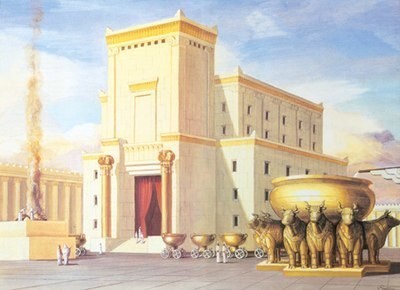
In Muslim tradition, the Temple Mount is also identified as the "furthermost sanctuary" (Arabic: المسجد الاقصى, Al-Masjid al-‘Aqṣā) from which the Prophet Mohammed, accompanied by the Angel Gabriel, made his Night Journey to the Throne of God (The Koran, Sura Al-Isra’ 17:1). So when Caliph Omar ibn al-Khattab conquered Jerusalem in 638 CE, he ordered the clearing of the site and the building of a "house of prayer." Some 50 years later, the Umayyad Caliph, Abd al-Malik, built the Dome of the Rock to enshrine the outcrop of bedrock believed to be "the place of the sacrifice" on Mount Moriah. He (or his son, the Caliph al-Walid I) also built in 1033 CE the large mosque at the southern end of the Haram, which came to be called al-Aqsa, after the Koranic name attributed to the entire area.
After the conquest of Jerusalem by the crusaders, the Dome of the Rock was converted into a church and called Templum Domini (the Temple of the Lord), and al-Aqsa became a church called Templum Solomonis (Solomon's Temple). They were reconverted into Muslim houses of worship after Saladin's conquest of Jerusalem in 1187 CE, and have remained so ever since.
During the 1948 Israeli War of Independence, Jordan retained control over Jerusalem's Old City and the Temple Mount and subsequently refused entry to the area to any Jewish person. During the 1967 Six-Day War, the Israeli Defense Forces captured Jerusalem, reclaiming Jewish control over the Temple Mount for the first time since the destruction of the Second Temple. Though Israel could have taken control of them, the Islamic holy places were put in the care of a Muslim Council, and Jews were barred from praying on the Mount in the hope of minimizing bloodshed and preventing a holy war.
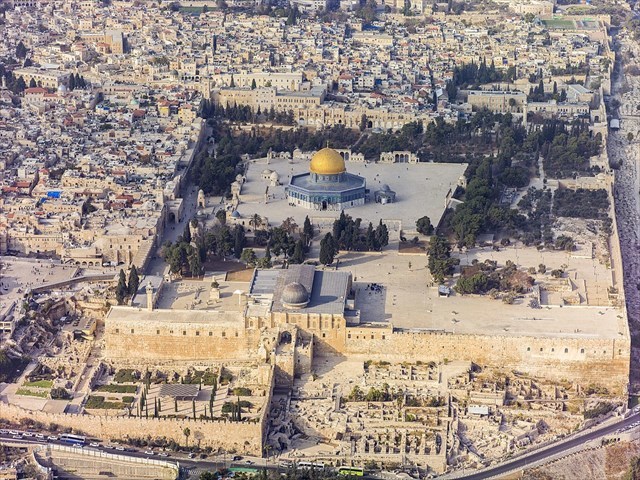
The Temple Mount Today
Currently an Islamic Waqf, or religious committee, manages the Temple Mount, though Israel provides security and upholds decisions made by the waqf about access to the site. For Jews, visiting the Temple Mount is a very controversial subject- both in terms of religious allowance and because non-Muslim prayer is prohibited at the site. Although freedom of access to the site is enshrined as law, Israel does not allow non-Muslim prayer on the Mount so as not to offend Muslim worshipers. Beyond this, many rabbi's argue that since the Jewish Temple's Holy of Holies stood near the center of today's Temple Mount, Jews are religiously forbidden from entering the area.
Arabs can enter the Temple Mount through one of ten different Muslim-only gates from various sites in the Old City. Tourists and Jews are only allowed access to the site by climbing a wooden ramp to enter through the Mugrabi Gate (seen below), which is located just above and to the left of the Western Wall plaza. Because of the sensitivity of the Temple Mount, Israelis enforce strict security measures for Jews and Muslims alike. For instance, during Friday prayers, any Muslim under the age of 45 is prohibited from ascending the mount; a rule put in place in response to young demonstrators throwing stones at Jewish worshipers at the Western Wall. Additionally, no Jewish groups can pray in the plazas surrounding the mosques or provoke the Muslims.
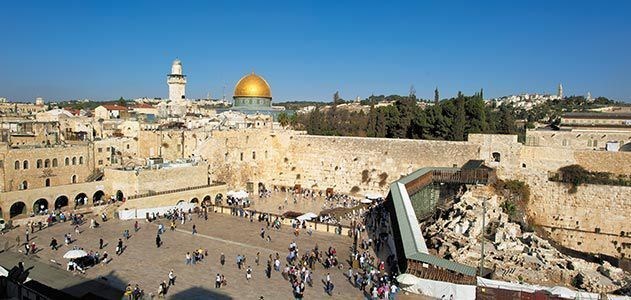
The Structure of the Temple Mount
The Temple Mount is the trapezoid-shaped, walled-in area in the southeastern corner of the Old City of Jerusalem. The four walls surrounding it date back – at least in their lower parts – to the time of the Second Temple. These huge supporting walls, which over the millennia have become partially buried underground, were built around the summit of the eastern hill identified as Mount Moriah. The gaps between the walls and the mount were filled in to create a large surface area around the Temple. Its eastern wall and the eastern half of its southern wall form part of the city wall on those sides. Deep valleys (now partly filled by debris) run outside the walls (northeast, east, south, west), thus separating the Temple Mount from and elevating it above its surroundings, both inside and outside the city.
The entire enclosure consists of an esplanade or courtyard, surrounding an elevated platform occupying approximately 36 acres of land and decorated by arched structures around the Dome of the Rock. In each of the walls there are a number of gates. Some of the gates, such as the Golden Gate, are blocked, while others are still in service. Within the area of the Temple Mount there are about 100 different structures from various periods, among them great works of art and craftsmanship, including open Muslim prayer spots, arches, arched porticos, Muslim religious schools, minarets, and fountains (some for drinking and others for worshipers to wash their hands and feet before prayer). Underneath the present-day surface, in the "artificial" parts of the mount, there are 34 cisterns. There are also other substructures, the largest of which is known as "Solomon's stables."
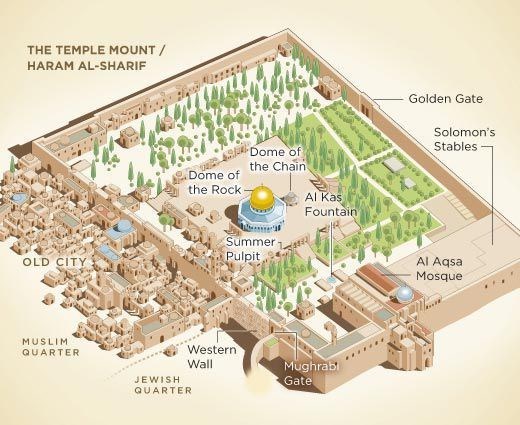
The Foundation Stone
The Foundation Stone (Hebrew: אבן השתייה Even ha-Shtiyya or Hebrew: סֶּלַע Selā‛, Arabic: صخرة Sakhrah "Rock") is the name of the rock at the center of the Dome of the Rock shrine. It is also known as the Pierced Stone because it has a small hole on the southeastern corner that enters a cavern beneath the rock, known as the Well of Souls. There is a difference of opinion in classical Jewish sources as to whether this was the location of the Holy of Holies or of the Outer Altar. If indeed this was the site of the Holy of Holies, that would make this the holiest site in Judaism (Tanhuma, chapter 10).
Jewish tradition views the Holy of Holies as the spiritual junction of Heaven and Earth, the axis mundi, and is therefore the direction that Jews face when praying. However, the alternate view that this was the site of the Outer Altar is bolstered by the existence of the holes in the stone, which may have served various sacrificial purposes in the Outer Altar. From a classical Jewish textual standpoint, there is no conclusive opinion on the matter.
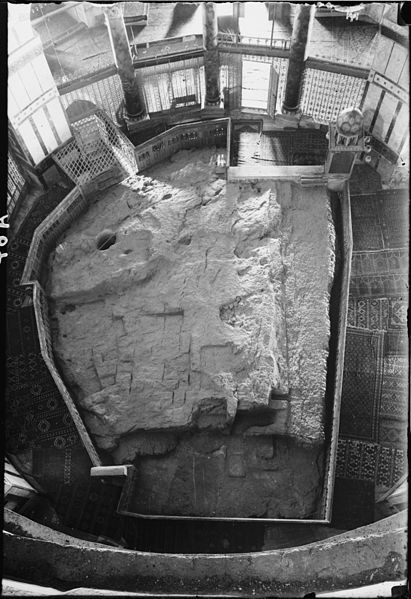
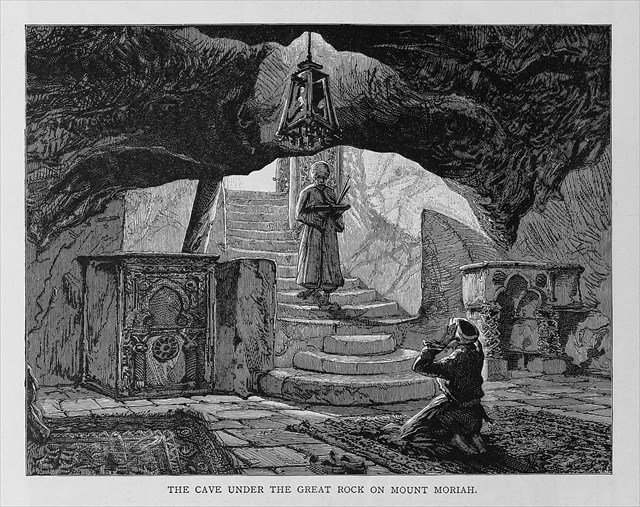
Sources:
https://en.wikipedia.org/wiki/Solomon's_Temple
https://en.wikipedia.org/wiki/Second_Temple
https://en.wikipedia.org/wiki/Temple_Mount
http://www.jewishvirtuallibrary.org/the-temple-mount
I would also like to acknowledge moooment, who was also planning on placing a virtual cache here, and gave me some helpful suggestions for improving this cache.
Visiting Hours:
Access to the wall surrounding the Temple Mount, including the Western Wall, is available 24/7. However, access to the Temple Mount itself is restricted and changes from time to time. There is no entrance fee, but you may need to undergo a security check. Non-Muslims can access the Temple Mount from Sunday through Thursday, during the following times*:
Summer: 07:30-11:00 and 13:30-14:30
Winter: 07:30-10:30 and 12:30-13:30
*These hours can change without notice.
Logging Requirements: (send only by message)
To get credit for this cache you don't need to physically reach the temple mount, but you do need to be close enough to see it. Then, please send me a MESSAGE (not email!) with the following information: your username (and members of your team if you're answering together), your country or origin, and the answers to at least 4 of the following 5 questions:
- How did you reach the temple mount? What entrance did you use?
- At what date and hour did your visit take place?
(Note: try to be exact. If you don't remember you can check the timestamps on your photos)
- On what side of the dome is the dome opening with the ladder (see photo below)? Please state your answer as a numeric azimuth* or a cardinal direction.
- In a few sentences, describe your experience upon reaching the temple mount.
- In your log, upload a photo of your finger being "pricked" by the spire of the Dome of the Rock. Your face does not need to be visible. Logs with edited photos will be deleted.
IMPORTANT: Please send me the the answers by *messaging me* through my geocaching profile, NOT email. GC emails simply don't reach me. "Found" logs of people who did not fulfill at least 4 of these 5 requirements will be deleted. If you feel that you can't answer the questions, you are always welcome to log a "note", and use that to share your photos and experiences.
* "Azimuth" is a clockwise numbering system used to accurately describe a direction using numbers from 0 to 360. North is 0, East is an azimuth of 90, South is 180, and west is 270.

Virtual Reward - 2017/2018
This Virtual Cache is part of a limited release of Virtuals created between August 24, 2017 and August 24, 2018. Only 4,000 cache owners were given the opportunity to hide a Virtual Cache. Learn more about Virtual Rewards on the Geocaching Blog.